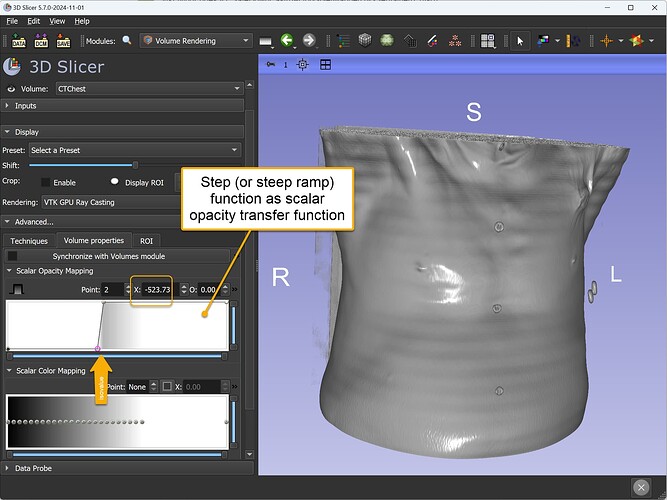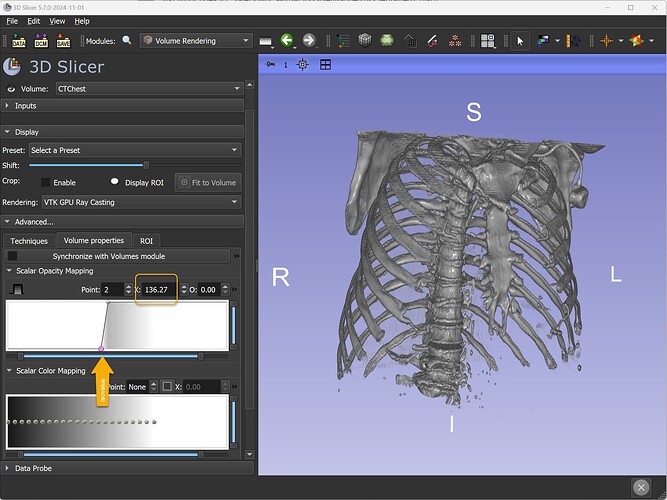Currently, I want to extract the isosurface from a volume image, and I use vtk.vtkMarchingCubes to implement it. Moreover, I want to change the iso-value by mouse. I have implement the code as following:
import vtk, sys
from vtk.qt.QVTKRenderWindowInteractor import QVTKRenderWindowInteractor
from PyQt5.QtWidgets import *
from PyQt5.QtGui import *
from PyQt5.QtCore import *
val = [1000, None]
def setVal(v):
val[0] = v
val[1].SetValue(v)
class MyInteractor(vtk.vtkInteractorStyleTrackballCamera):
def __init__(self):
self.AddObserver("LeftButtonPressEvent", self.leftButtonPressEvent)
self.AddObserver("LeftButtonReleaseEvent", self.leftButtonReleaseEvent)
self.AddObserver("MouseMoveEvent", self.leftButtonMoveEvent)
self.btnPress = False
self.lastPoint = [0, 0]
def leftButtonPressEvent(self, obj, event):
self.btnPress = True
pos = self.GetInteractor().GetEventPosition()
self.lastPoint = [pos[0], pos[1]]
def leftButtonReleaseEvent(self, obj, event):
self.btnPress = False
def leftButtonMoveEvent(self, obj, event):
if self.btnPress == True:
curPos = self.GetInteractor().GetEventPosition()
dx = curPos[0] - self.lastPoint[0]
dy = curPos[1] - self.lastPoint[1]
isoValue = val[0]
if abs(dx) > abs(dy):
isoValue += dx
else:
isoValue += dy
setVal(isoValue)
self.lastPoint = [curPos[0], curPos[1]]
else:
super().OnMouseMove()
class MainWindow(QMainWindow):
def __init__(self, parent=None):
super(MainWindow, self).__init__(parent=parent)
self.frame = QFrame()
self.vl = QVBoxLayout()
self.vtkWidget = QVTKRenderWindowInteractor(self.frame)
self.vl.addWidget(self.vtkWidget)
self.ren = vtk.vtkRenderer()
self.vtkWidget.GetRenderWindow().AddRenderer(self.ren)
self.iren = self.vtkWidget.GetRenderWindow().GetInteractor()
style = MyInteractor()
self.iren.SetInteractorStyle(style)
reader = vtk.vtkDICOMImageReader()
reader.SetDirectoryName("C:\\Users\\MLoong\\Desktop\\Angiograph Data\\Chang Cheng\\TOF")
reader.Update()
surface = vtk.vtkMarchingCubes()
surface.SetInputConnection(reader.GetOutputPort())
surface.ComputeNormalsOn()
surface.SetValue(0, 300)
surface.Update()
self.surface = surface
# Create a mapper
mapper = vtk.vtkPolyDataMapper()
mapper.SetInputConnection(surface.GetOutputPort())
mapper.ScalarVisibilityOff()
# Create an actor
actor = vtk.vtkActor()
actor.SetMapper(mapper)
actor.GetProperty().SetColor(1, 1, 1)
actor.GetProperty().ShadingOff()
self.ren.AddActor(actor)
self.ren.ResetCamera()
self.frame.setLayout(self.vl)
self.setCentralWidget(self.frame)
self.show()
self.iren.Initialize()
def SetValue(self, val):
print(val)
self.surface.SetValue(0, val)
self.surface.Update()
self.vtkWidget.GetRenderWindow().Render()
if __name__ == "__main__":
app = QApplication(sys.argv)
window = MainWindow()
val[1] = window
sys.exit(app.exec_())
This code has no bug after provide a correct image in reader.SetDirectoryName(“path”). I can change the iso-value by left mouse press and move. But the problem is that the speed is slow. Does anybody has any suggestion to speed it up?


